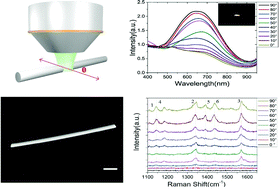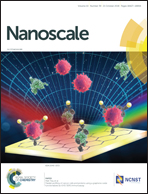Polarization-dependent surface plasmon-driven catalytic reaction on a single nanowire monitored by SERS†
Abstract
The polarizing effect of an excitation laser on a plasmon-driven catalytic reaction on a single nanowire (NW) was investigated experimentally and theoretically. The dimerization of 4-nitrobenzenethiol (4NBT) to p,p′-dimercaptoazobenzene (DMAB) due to localized surface plasmon resonance (LSPR) was realized and monitored via surface enhanced Raman scattering (SERS). The SERS signal degradation has been compensated by using different equivalent points on the NW. It was shown that the SERS signals of both the reactant and product were sensitive to the angles (θ) between the longitude of the NW and the polarization direction of the excitation laser. When the polarization is along the transverse direction of the NW, the SERS signals are drastically enhanced by the LSPR. The efficiency of the plasmon-driven catalytic reaction increased significantly. The mechanism of the polarization-dependent plasmon-driven catalytic reaction was revealed by our dark field experiment and numerical finite-difference time-domain simulation. It was demonstrated that the maximum intensity of the electric field near the surface of the NW would also be a function of the angle θ. The theoretical and experimental results were consistent with each other. This research may pave a way for controlling plasmon-driven catalytic reactions by changing the polarization of an excitation laser incident on single anisotropic nanostructures such as a single NW.



 Please wait while we load your content...
Please wait while we load your content...